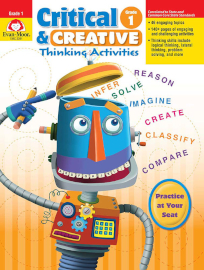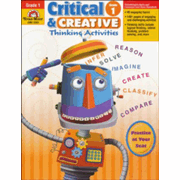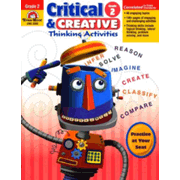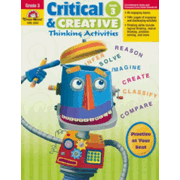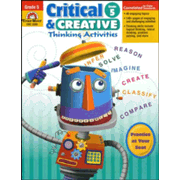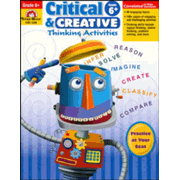The Critical & Creative Thinking Activities series of reproducible workbooks for grades one through six teaches thinking skills through activities that require students to analyze and apply critical thinking skills as well as imagination and creativity. The intro to each workbook tells us it was created to “keep students actively involved in learning during free time or while you’re working with other students.” To make that happen, the activities need to be interesting enough to engage students working independently. So these workbooks include activities such as visual brainteasers, logic puzzles, creative writing and drawing, language play (analogies, similes, anagrams, etc.), and “What if?” type questions.
The content of each workbook is presented under themes, such as seasons and holidays, popular fairy tales, animals, and places. Math and language arts are often applied in the activities, and many lessons relate to science.
Each workbook has 46 themes (or lessons), with three pages per theme. Students might complete one or more pages per session—they don’t need to complete all pages of a theme on the same day. While themes group activities together, students can skip around, even selecting some activities and skipping others.
Here’s a description of activities in the Grade 3 book for the theme “Feasting in November.” The first page of the lesson begins by asking students, “The answer is November. What is the question?” and “The answer is Thanksgiving. What is the question?” Students might come up with several appropriate questions for each of these, but they write only one in the space provided in the workbook.
Next is a question that involves some math. Students are told a turkey must be cooked for 20 minutes per pound. They must determine the cooking time for five different weights of turkeys. The third activity asks students to name Thanksgiving foods that start with the five letters T, P, C, G, and S, then answer a question about their own favorite Thanksgiving Day food.
The second page of the lesson has students number things they are thankful for in order of priority to them. For the second activity, students come up with a Thanksgiving menu that does not include “turkey, mashed potatoes, or any of the usual Thanksgiving Day foods.” The final activity on that page presents “riddles” for students to identify additional holidays that occur regularly, such as “the 4th day of the seventh month.”
Page three of the November theme has only one activity, but it involves critical thinking, math, and drawing. Students are given a scenario for hosting a Thanksgiving dinner that includes 18 guests, four small tables, and two large tables. Each table seats a certain number of people. They must “arrange the table so that every table is used, everyone has a seat, and there are no empty spaces,” drawing their results in the space provided.
You can see that some activities can be answered quickly while others take more time. Answer keys are at the back of each book.
These reproducible workbooks are available either in print or as PDF ebooks.
Summary
The variety of activities in every book in the Critical & Creative Thinking Activities series plus their suitability for independent study make them a good choice for homeschooling families.




